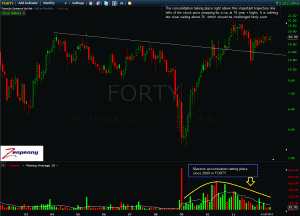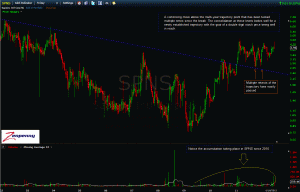RESEARCH REPORT: SPNS CAUGHT IN A PERFECT STORM OF PROSPERITY
*6-19-12 - Since Friday I have been accumulating shares of SPNS for portfolios. It is a mid-sized position at an average price of 3.98. What follows are the compelling reasons behind the decision to invest in SPNS.
*5-7-13 - SPNS sold for a 40% profit
We begin with a very simple problem: The modern-day insurance industry is under increasing pressure to evolve into a more streamlined, efficient entity. The debt crisis that is slithering its way through developed economies has created an environment whereby financial companies (insurance included) are under increasing scrutiny. Frightened shareholders punish mistakes at an exaggerated rate, leading corporate executives to grasp onto corporate efficiency as the primary means of placating investors. The ultimate goal, of course, is to create value in an environment that is under constant threat of macro shocks.
The problem of efficiency in the insurance industry has roots in many places. One of the primary problems is the fact that insurance companies are relying on outdated legacy systems that are increasingly falling behind the technological innovations of the past several years. These legacy systems have been in place for decades at many companies, having simply been band-aided together in order to avoid the cost and headaches involved with a major upgrade. Avoiding the short-term upgrade cost, however, has resulted in increasing long-term maintenance costs, regulatory concerns and limited functionality that inhibits growth.
What all of this translates into is a minute by minute furnace in the office that is burning dollars through inefficiency during a point in time when burning dollars is no longer tolerated. It is not a matter of "if" but rather a matter of "when" ALL of these legacy systems will be upgraded.
"Technology innovations, including social networking, telematics, SOA and beyond, will play a major role in determining success or failure in the insurance industry. Firms that effectively harness technologies and the opportunities they offer are destined to be among the industry winners, leading the way toward growth and prosperity. Companies that fail to keep up with the latest technologies—those mentioned in this paper and the lasting "next-gen" innovations that arrive on the scene—risk falling further behind and relinquishing their leadership positions. Make no mistake, the insurance industry is at a pivot point as future success is likely to rest on today's technology decisions and strategies." http://www.atkearney.com/index.php/Publications/technology-the-insurance-industrys-pivot-point.html
Well researched estimates put the number of insurance companies that are still holding onto their old legacy systems at 80%. This is within a $50 billion insurance software industry.
Post-2008 the fiscal conservatism that has become the financial industry has led to gobs of cash on the balance sheet being available for just these types of efficiency improvements. The consistent increase in speed with which technology is progressing has put increasing pressure on these legacy systems at a time when companies have the cash to make the upgrades.
The upgrades are just now starting to occur in bunches rather the single serve expectation of just 12 months ago. Insurance companies are becoming proactive. The companies that provide total software solutions for insurance companies stand to gain the most in the coming years.
"We're really anchored in core system replacement," says SMA founder Deb Smallwood, who spoke at the Executive Summit. "Twelve percent of insurers say they're going to replace their policy systems over the next year or so, and 18 percent are doing major enhancements; that's 30 percent doing something significant." http://www.insurancetech.com/management-strategies/232200685
Enter SPNS: Sapiens Intl. is an Israeli company that provides software solutions for insurance companies worldwide. They are a 30 year old company that is well established within the insurance software industry. Given the recent acquisitions (I'll get to that later) they have made, SPNS is now at a size where tier 1 insurance companies will come knocking on their door in order to service their software needs. They are a major player within the industry. The opportunity lies in the fact that the market hasn't caught onto the fact that their earnings are increasing at an impressive rate due to the spate of insurance company upgrades currently taking place and on tap. In addition, the market doesn't realize that SPNS will be a "go to guy" for those upgrades.
Q1 2012 earnings for SPNS were released on May 8th. The results are noteworthy:
- Revenue increased 95% to $26.0 million, compared to $13.3 million in the first quarter of 2011;
- Non-GAAP net income increased 63% to $3.2 million compared to $2.0 million for first quarter of 2011;
- Non-GAAP operating profit increased 63% to $3.3 million, compared to $2.0 million in first quarter of 2011;
- Non-GAAP EPS is $0.08 per diluted share, compared to $0.08 per diluted share in first quarter of 2011;
- The Company ended the quarter with $27.1 million in cash, compared to $21.5 million at December 31, 2011.
Commenting on the first quarter results, Roni Al Dor, President and CEO of Sapiens International, "The first quarter was a good start for Sapiens, as we begin our first full year following the acquisitions of IDIT and FIS. Our revenue grew by 95%, non-GAAP net income & non-GAPP operating profit both increased 63.0%. We will continue to improve the operational efficiencies of the newly acquired entities and expand the margins, as we have done many times in the past, with other companies, including Sapiens itself."
Guidance was reiterated for revenues in excess of $100 million for 2012. At current market capitalization, SPNS is trading at 1.5 times projected sales in an industry that typically rewards profitable, growing companies with a 3-5 times ratio. The $100 million sales number for 2012, however, is not where the real opportunity lies. The real opportunity comes with the growth that has a substantial probability of occurring due to legacy systems upgrades during the next 12 to 18 months.
The CEO has publicly set a goal of $200 million in sales for 2014 based on this opportunity. He has said that the goal is based on industry expectations and SPNS's increasing ability to execute efficiently for current and future clients. 70% of that growth is slated to come from current clients and 30% from new clients.
The list of current clients, by the way, is substantial. Here is a list of the majors:
- Allianz
- AXA
- ING
- Occidental
- Barclays
- Santander
- Principal
Using the $200 million sales number at 3-5 sales gives us a current market cap that has upside of 300% conservatively and close to 500% should the market begin rewarding the company aggressively. Realistically, this is an insurance software provider. Therefore, the "buzz factor" involved will likely keep the premium at 3-4 times sales.
The $4 current stock price obviously has some upside work to do. Even based on current sales, the company has upside of 100% in order to fall in line with the normal premium assigned to software companies that are growing, profitable, have no debt and are cash flow positive. SPNS possesses all of the aforementioned attributes. It is simply being overlooked.
Now for a review of the merger with FIS and IDIT that closed in 2011. The deal seems to have been made with an eye on propelling the company into the ranks of only a few companies with the capability of providing systems across all aspects of insurance including life, property, annuity and reinsurance. Bear in mind, this is a 30 year old company that is very familiar with the cycles that naturally occur within the insurance software industry. It is only proper to assume that these acquisitions are being made for the purpose of both capitalizing on the substantial upgrade cycle that awaits over the next 12 to 18 months AND to provide a full suite of solutions to customers.
FIS offers solutions for life, pension and annuity insurers in North America, Europe, and Asia, and IDIT provide property and casualty solutions, mainly in Europe, Australia and Asia Pacific.
Additionally, an important threshold has now been crossed as it has been a year since the deal closed. The always precarious process of integrating not one but two new entities into SPNS has been successful. The most recent earnings report and reiteration of guidance is a testament to that fact.
Onward and upwards now to the beneficial relationship that SPNS has with its parent company Formula Systems (Nasdaq: FORTY). The structure of FORTY is somewhat rare for today's marketplace. It does, in fact, remind me very much of the technology incubators and holdings companies that became popular during the tech boom up to 2000. As described by the profile on Yahoo Finance: FORTY Formula Systems (1985) Ltd., through its subsidiaries, operates as an information technology (IT) solutions and services company worldwide.
Keyword in the profile is subsidiaries. They include: BPHX, MGIC and SPNS. Formula Systems is very much in the business of maximizing value for these companies through focus on a niche marketplace within the software space. Formula Systems has been increasing their stake in SPNS as recently as January of this year, purchasing an additional two million shares at an average price of $4.11 between December 2011 and January 2012 through private transactions. The reasons for the purchases were described as "long-term investment" on the SEC 13D filing dated January 27th, 2012.
It should also be noted that based on the quick work I've done on FORTY, the valuation of the company is trading at a substantial discount given the value of their subsidiaries on a current and forward looking basis. The technical pattern seems to be pointing to a move above 30 over the next 12-18 months in the stock, as illustrated in the chart below:
click chart to enlarge
While on the subject of charts, let's now take a look at SPNS on a long-term basis:
click chart to enlarge
Risks: The greatest risk to SPNS is of the macro variety. We are in an environment that is under constant threat of macro shock, currently of a European flavor. These shocks, for obvious reasons, have a negative influence on the financial sector more than any other. With that said, further unexpected macro shocks that government intervention can no longer absorb will curb whatever IT upgrade plans insurance companies have. If the shocks are substantial, insurance company spending on IT upgrades will freeze completely for a period of time.
Additionally, SPNS is an Israeli company. There are geopolitical risks associated with this region of the world.
Summary: SPNS has positioned itself perfectly to take advantage of the inevitable upgrade cycle that is in the process of taking place in the insurance industry. With recent acquisitions that were purposely pursued with the goal of being a full service provider to even tier 1 insurance companies, SPNS has become a destination of choice for insurance providers seeking to upgrade their legacy systems. Recent earnings growth, a perfectly clean balance sheet and positive cash flow only make the opportunity more compelling. Additionally, the technical picture speaks of a company that is under accumulation and seems to prepping itself for a run into the double digits over the next 12 to 18 months. And the fundamental picture also confirms a price target substantially higher based on a reasonable multiple assigned to a company whose own CEO has said that a $200 million annual revenue goal by 2014 is obtainable. The price target based on both fundamental and technical evaluation is $15 over the next 12 to 18 months.


